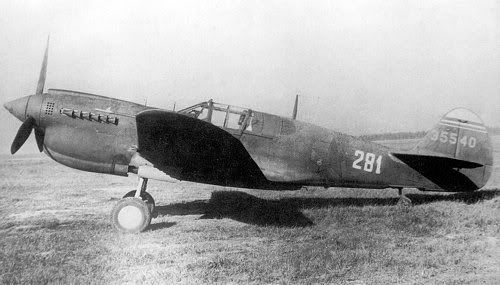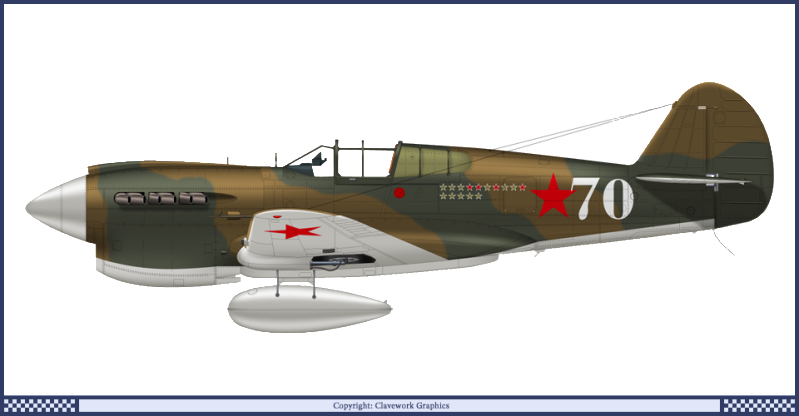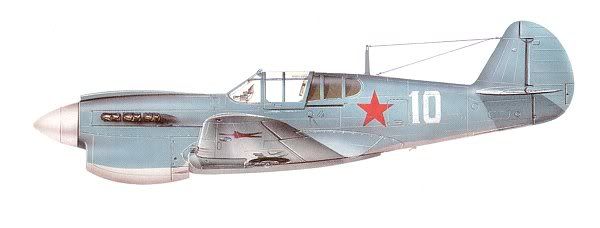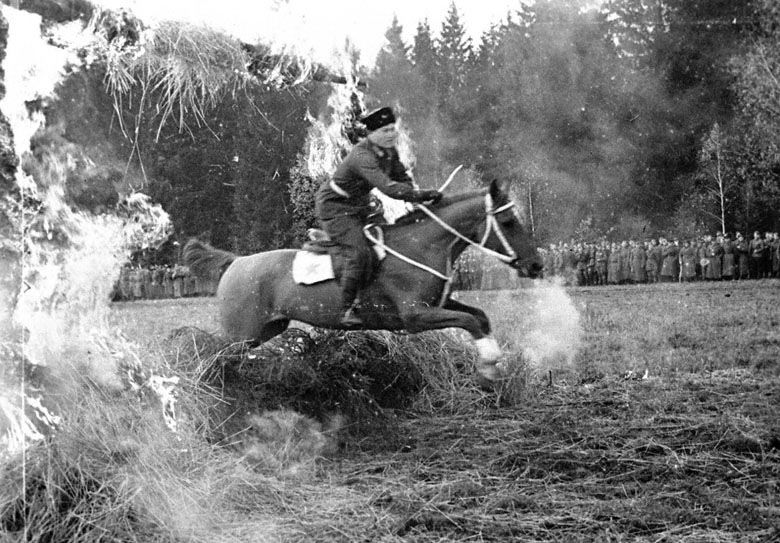Post by horsesoldier176 on Apr 26, 2010 12:39:39 GMT -5
Though only moderately popular with the Soviets, the Soviet Air Force used the relatively few P-40s they had been given quite extensively against the Germans on the Eastern front; most Soviet P-40 squadrons had good combat records. The Warhawk provided close air support as well as air-to-air capability for the Soviet Air Force, with many Soviet pilots becoming aces on the P-40 (although not as many as on the P-39 Airacobra, which was the most popular American fighter used by the Soviet Air Force).
The Soviets stripped down their P-40s significantly for combat, in many cases removing the wing guns altogether in P-40B/C types, for example. Soviet Air Force reports state that they liked the range and fuel capacity of the P-40 which were superior to most of the Soviet fighters, though they still preferred the P-39. Their biggest complaint was its poor climb rate and problems with maintenance, especially with burning out the engines. VVS pilots usually flew the P-40 at War Emergency Power settings while in combat, this would bring the acceleration and speed performance closer to that of their German rivals, but could burn out engines in a matter of weeks. They also had difficulty with the more demanding requirements for fuel quality and oil purity of the Allison engines. A fair number of burnt out P-40s were re-engined with Soviet Klimov engines but these performed relatively poorly and were relegated to rear area use.
The P-40 saw the most front-line use in Soviet hands in 1942 and early 1943. It was used in the northern sectors and played a significant role in the defense of Leningrad. The most numerically important types were P-40B/C, P-40E and P-40K/M. By the time the better P-40F and N types became available, production of superior Soviet fighters had increased sufficiently so that the P-40 was replaced in most Soviet Air Force units by the Lavochkin La-5 and various later Yakovlev types.
Many stories have been told and retold by pilots grateful for their plane’s solid construction.
One unique account was that of Lt. Alexi Khobistoff of the Red Air Force, who perfected an unusual method of destroying enemy aircraft when his plane’s guns froze from ice build-up. With his sights set on a Heinkel 111, the distracted Khobistoff struggled to clear his guns when all of a sudden the prop of his plane tore through the bomber’s wing. He managed to stay airborne while his target careened into the ground. He repeated this act a second time, but on this day it was intentional, cutting the rudder off of yet another German bomber. The third time and his fifth kill happened when a 109 mortally wounded his plane. Rather then go out quietly, the tenacious Khobistoff dove his plane into the nearest enemy fighter he saw, chewing its tail to bits. He bailed out and spent several weeks in the hospital, never to repeat his unorthodox tactic.

I just read the interview (see first link) with General-Major Nikolay Gerasimovich Golodnikov (retired), who flew with Boris Safonov in Hurricanes and P-40s. Golodnikov flew enormous number of various piston and jet-engine fighters in his career-from I-16 to Su-15TM. His opinion about fighter capabilities of US types (P-39 and P-40) is rather high (and it is not the usual “good radio” thing).
This is the translation of, maybe, most important part about P-40 capabilities:
Q. “I will cite Mike Spick to you; that is recognized military aircraft historian: “Some units of the Air Force, like on Malta or North Africa, had to fight with the second-grade aircraft. Firstly those were Gloster Gladiator biplanes and war-weary Hurricanes I. Then, in June 1941 and April 1942, Curtiss P-40 Tomahawk and Kittyhawk were introduced. Deemed inferior for use as fighter in Europe, they were sent to the desert where they could counter most of the Italian fighters, although they could not be matched to German Bf-109E and F…”
Golodnikov: “Well, that what Allies [i.e., British and American pilots] thought, that it is not wise or almost impossible fight with P-40, I knew all the time during the war. P-40 was thought of as quite good fighter with us. When we started to use P-40, we immediately found two drawbacks that were reducing its value of a fighter:
1. P-40 was “dull” in acceleration; it would accelerate quite slow. Poor acceleration dynamics resulted in the low combat speed. It was hard to obtain speed necessary for the air combat. Speed is the ultimate thing for a fighter.
2. Poor vertical, especially Tomahawk.
The first and second was the result of the lack of power. What we did was simple. First drawback we removed by holding higher RPM. We always flew it with increased RPM. Second: we took (wing-installed) guns off. That was it. Fighter became “on par”. It all depended of yourself, the most important thing was not to be lazy, to work more intensive with the throttle. Truth to be told, engines were “burning away” from our unusual settings. They would last up to 50 hours, often shorter. They would usually clock up to 35 hours and then be replaced.
Q. And of your intensive work with throttle would do “abracadabra” (translator’s. note: according to Golodnikov, Tomahawk—but not Kittyhawk—would sometimes tumble “head over heels”, depending of the throttle or harsh stick movement!). Allies found many drawbacks of “Tomahawks”, but “abracadabra” was not mentioned. Why?
Golodnikov: I don’t know, but “Tomahawk” had that drawback.
Q. and all in all, there is a serious difference in evaluations. Could it be from the different Soviet and Allied tactics?
Golodnikov: Main difference in the assessment of P-40′s combat capabilities comes from that we and Allies had completely different exploitation of the aircraft. They use it as written in manuals, from letter to letter. We, as I said before, had a main rule is to take from the machine everything possible. How much “everything” is, it did not write in manuals, and even airplane designer didn’t anticipate. This appears in combat. Everything said above goes for Aircobra, too. Have we flown them how Americans wrote it in the manual, we would all got shot down. It was a dud as the fighter aircraft on “birth” regime. On our regimes we had a equal combat with either “Me’s” or “Fw’s”, but it would have meant 3-4 combats with subsequent engine change.
Curtiss P-40 Kittyhawk

Curtiss P-40E Kittyhawk

Curtiss P-40 Tomahawk

Curtiss P-40 Safonof

Boridin
The Soviets stripped down their P-40s significantly for combat, in many cases removing the wing guns altogether in P-40B/C types, for example. Soviet Air Force reports state that they liked the range and fuel capacity of the P-40 which were superior to most of the Soviet fighters, though they still preferred the P-39. Their biggest complaint was its poor climb rate and problems with maintenance, especially with burning out the engines. VVS pilots usually flew the P-40 at War Emergency Power settings while in combat, this would bring the acceleration and speed performance closer to that of their German rivals, but could burn out engines in a matter of weeks. They also had difficulty with the more demanding requirements for fuel quality and oil purity of the Allison engines. A fair number of burnt out P-40s were re-engined with Soviet Klimov engines but these performed relatively poorly and were relegated to rear area use.
The P-40 saw the most front-line use in Soviet hands in 1942 and early 1943. It was used in the northern sectors and played a significant role in the defense of Leningrad. The most numerically important types were P-40B/C, P-40E and P-40K/M. By the time the better P-40F and N types became available, production of superior Soviet fighters had increased sufficiently so that the P-40 was replaced in most Soviet Air Force units by the Lavochkin La-5 and various later Yakovlev types.
Many stories have been told and retold by pilots grateful for their plane’s solid construction.
One unique account was that of Lt. Alexi Khobistoff of the Red Air Force, who perfected an unusual method of destroying enemy aircraft when his plane’s guns froze from ice build-up. With his sights set on a Heinkel 111, the distracted Khobistoff struggled to clear his guns when all of a sudden the prop of his plane tore through the bomber’s wing. He managed to stay airborne while his target careened into the ground. He repeated this act a second time, but on this day it was intentional, cutting the rudder off of yet another German bomber. The third time and his fifth kill happened when a 109 mortally wounded his plane. Rather then go out quietly, the tenacious Khobistoff dove his plane into the nearest enemy fighter he saw, chewing its tail to bits. He bailed out and spent several weeks in the hospital, never to repeat his unorthodox tactic.

I just read the interview (see first link) with General-Major Nikolay Gerasimovich Golodnikov (retired), who flew with Boris Safonov in Hurricanes and P-40s. Golodnikov flew enormous number of various piston and jet-engine fighters in his career-from I-16 to Su-15TM. His opinion about fighter capabilities of US types (P-39 and P-40) is rather high (and it is not the usual “good radio” thing).
This is the translation of, maybe, most important part about P-40 capabilities:
Q. “I will cite Mike Spick to you; that is recognized military aircraft historian: “Some units of the Air Force, like on Malta or North Africa, had to fight with the second-grade aircraft. Firstly those were Gloster Gladiator biplanes and war-weary Hurricanes I. Then, in June 1941 and April 1942, Curtiss P-40 Tomahawk and Kittyhawk were introduced. Deemed inferior for use as fighter in Europe, they were sent to the desert where they could counter most of the Italian fighters, although they could not be matched to German Bf-109E and F…”
Golodnikov: “Well, that what Allies [i.e., British and American pilots] thought, that it is not wise or almost impossible fight with P-40, I knew all the time during the war. P-40 was thought of as quite good fighter with us. When we started to use P-40, we immediately found two drawbacks that were reducing its value of a fighter:
1. P-40 was “dull” in acceleration; it would accelerate quite slow. Poor acceleration dynamics resulted in the low combat speed. It was hard to obtain speed necessary for the air combat. Speed is the ultimate thing for a fighter.
2. Poor vertical, especially Tomahawk.
The first and second was the result of the lack of power. What we did was simple. First drawback we removed by holding higher RPM. We always flew it with increased RPM. Second: we took (wing-installed) guns off. That was it. Fighter became “on par”. It all depended of yourself, the most important thing was not to be lazy, to work more intensive with the throttle. Truth to be told, engines were “burning away” from our unusual settings. They would last up to 50 hours, often shorter. They would usually clock up to 35 hours and then be replaced.
Q. And of your intensive work with throttle would do “abracadabra” (translator’s. note: according to Golodnikov, Tomahawk—but not Kittyhawk—would sometimes tumble “head over heels”, depending of the throttle or harsh stick movement!). Allies found many drawbacks of “Tomahawks”, but “abracadabra” was not mentioned. Why?
Golodnikov: I don’t know, but “Tomahawk” had that drawback.
Q. and all in all, there is a serious difference in evaluations. Could it be from the different Soviet and Allied tactics?
Golodnikov: Main difference in the assessment of P-40′s combat capabilities comes from that we and Allies had completely different exploitation of the aircraft. They use it as written in manuals, from letter to letter. We, as I said before, had a main rule is to take from the machine everything possible. How much “everything” is, it did not write in manuals, and even airplane designer didn’t anticipate. This appears in combat. Everything said above goes for Aircobra, too. Have we flown them how Americans wrote it in the manual, we would all got shot down. It was a dud as the fighter aircraft on “birth” regime. On our regimes we had a equal combat with either “Me’s” or “Fw’s”, but it would have meant 3-4 combats with subsequent engine change.
Curtiss P-40 Kittyhawk

Curtiss P-40E Kittyhawk

Curtiss P-40 Tomahawk

Curtiss P-40 Safonof

Boridin

